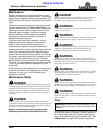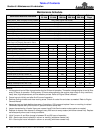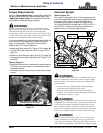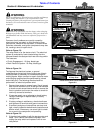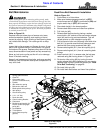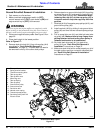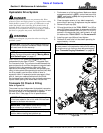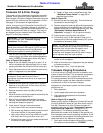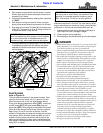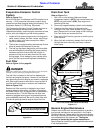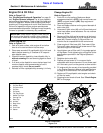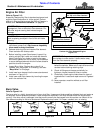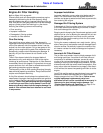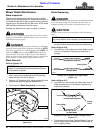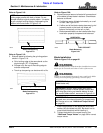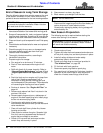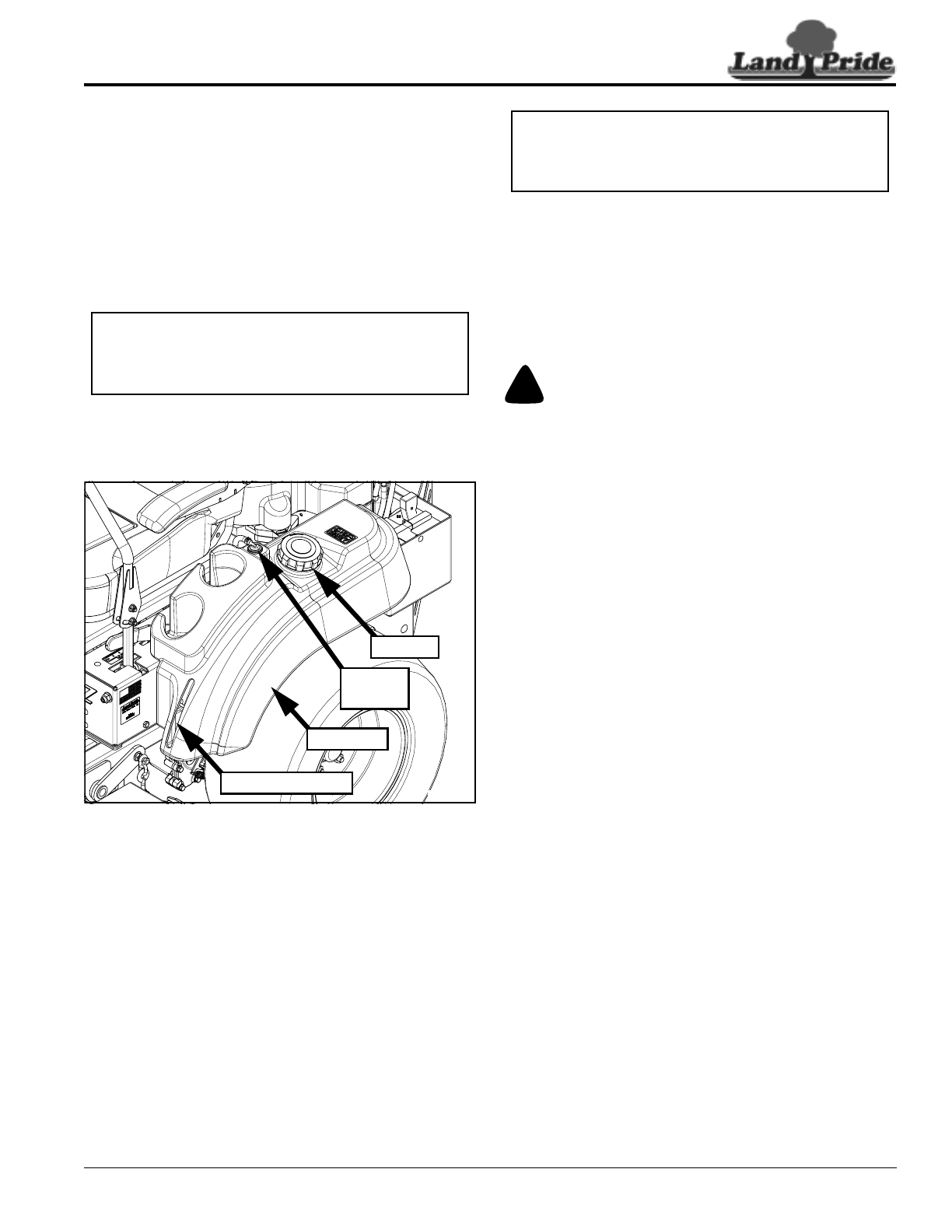
41
Section 5: Maintenance & Lubrication
ZT60i & ZT72i (S/N 748110+) Accu-Z
®
Zero Turn Mowers 357-552M
Table of Contents
2/06/14
2. Start engine and place both control levers in neutral.
Slowly move control levers completely forward and
rearward 5 to 6 times.
3. Close both bypass valves by rotating them clockwise
to “RUN”.
4. With engine running and control levers in neutral,
slowly move levers forward and reverse 5 to 6 times.
5. Stop engine and check fill tubes (#5) and expansion
tanks (#7). Squeeze all air from fill tubes and add oil
to expansion tanks if they are low.
6. It may be necessary to repeat Steps 1 to 5 until all air
is completely purged from the system, transaxle
operates at normal noise levels, and travels at
normal speeds.
Fuel Tanks (Left Side Shown)
Figure 5-9
Fuel System
Refer to Figure 5-9:
The fuel tanks are located in the mower fenders. Total
capacity of each fuel tanks is 6 U.S. gallons. Fill tank
when fuel shows low in the fuel sight gauge. Before
filling, push blade engagement switch (OFF), move both
control levers (OUT), set park brake (ON), and turn
switch key (OFF). Allow engine to cool before filling tank.
Clean dirt from around fuel tank cap. Remove cap and
begin filling. Do not fill fuel tank to the top. Fuel will
expand in hot weather and seep out through the fuel tank
vent system. When finished, screw cap back on until it
makes a clicking noise and ratchet action that can be
heard and felt when tight. Wipe up any spilled gasoline.
Use regular unleaded gasoline with an (R+M)/2 octane
rating of 87 or higher.
IMPORTANT: The transaxle is considered purged
when transaxles are at the proper oil level, operate
at normal noise levels, oil temperatures are not
excessively high, and mower does not lack power.
Fuel Cap
Fuel Tank
33784
Fuel Sight Gauge
Fuel Vent
Valve
Land Pride recommends adding correct amounts of gas
stabilizer/conditioner in the fuel. For best results, follow
engine manufacturer’s directions. Using a fuel stabilizer/
conditioner in the fuel can provide benefits such as:
1. Keeps gasoline fresh during storage of 90 days or
less. Drain fuel tank if storage is longer.
2. Cleans engine during operation.
3. Eliminates gum-like varnish build-up in the fuel system.
!
DANGER
• Replacement of fuel system parts (i.e. gas caps, hoses, fuel
tanks, fuel filters, etc.) must be the same as original parts.
Fire and/or explosion can occur if not followed.
• Observe safe fuel handling precautions. Fuel is flammable
and vapors are very explosive. An explosion or fire can
burn, destroy and kill property, animals and people.
• Do not fill tank with engine running or while engine is hot.
Allow engine to cool beforefilling. Fuel spilled over engine,
muffler, or hot objects may result in a fire or explosion.
• Allow engine to cool before servicing the fuel system.
• Do not smoke while handling fuel or around the fuel tanks.
• Do not fill fuel tanks to the top. Fuel will expand in hot
weather and seep out through the fuel tank vent system.
• Screw gas cap on immediately after filling a tank. Never
operate mower without gas caps installed.
• Clean up any gasoline spills immediately.
• Keep fuel away from open flame or spark.
• Store mower away from open flame and sparks.
• Refuel outdoors preferably, or in well ventilated areas.
• Never attempt to start the engine when there is a strong
odor of gasoline fumes present. Locate and correct cause.
• Never buy more than a 30 day supply of gasoline and store
it in an approved container out of children’s reach.
• Do not fill gasoline containers inside a vehicle, on a truck,
or on a trailer. Interior carpets and plastic truck bed liners
insulate the container and slow loss of static charge.
• When practical, remove equipment from the truck or trailer
and refuel the equipment with its wheels on the ground. If
this is not possible, then refuel the equipment on the truck or
trailer using a portable container and not a gasoline
dispenser nozzle. If a gasoline dispenser nozzle must be
used, keep nozzle in contact with rim of fuel tank or
container opening at all times until fueling is complete.
• Gasoline is a poison that is harmful or fatal if swallowed.
• Avoid prolonged breathing of vapors. Long-term exposure
to vapors can cause serious injury and illness.
• Keep face away from nozzle and gas tank opening.
• Keep gas away from eyes and skin.
IMPORTANT: The fuel system can be damaged if
the wrong fuel is used. Never use methanol, lead
gasoline, or unleaded gasoline containing more
than 10% ethanol. Do not mix oil with gasoline.



